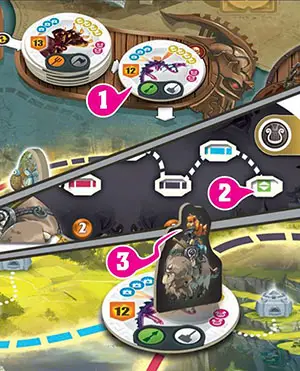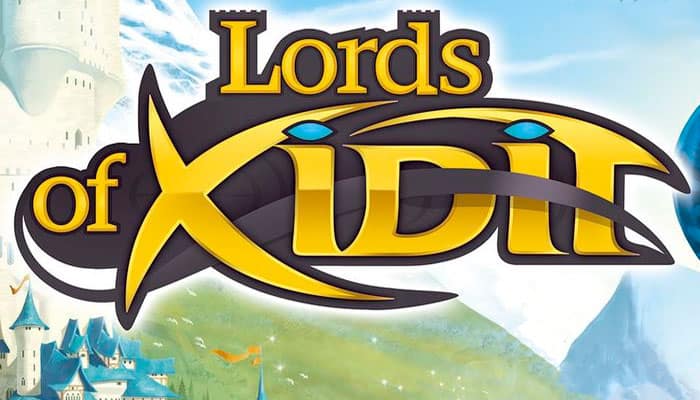
Your task is to travel the Kingdom of Xidit, recruit brave nits, free Cities from dark threats and become th 5avior. Your bravery, ingenuity and boldness will :d and future generations will sing your praises.
Components

- 70 Unit figurines of 5 different types
- 75 Sorcerers' Guild Story figurines
- 60 Gold Sovereign tokens
- 100 Bard tokens
- Assessment tiles
- 39 City tiles
- 6 Titan tiles
- 5 Screens
- 3 Calendar tiles
- 5 Idrakys
- 5 Programming Boards
- 1 First Player token
- 5 Order tokens
- 18 Score tokens
- 2 Empty tokens.
- 1 Year wooden token.
- 1 Bastion
- Dummy Player Board with 3 Dummy Player tokens
- 1 Game Board

Cities 1, numbered from 1 to 21. During the game, players can recruit Units in certain Cities. Other Cities require Units in order to eliminate threats.
Roads 2, in three different colors (black, red and blue). These roads run between Cities, enabling players to travel through the Kingdom of Xidit.
Nine Regions 3 bounded by roads. Bard tokens are placed in these regions as news of the players' deeds spreads throughout the kingdom. Bard tokens played in the central Region are placed secretly in the Bastion 4 . A lyre symbol and two related values in each Region show the Reputation boost earned at the end of the game by the players who placed the most Bard tokens in the Region 5.
The Path of Destiny 6, divided into two parts: the Recruitment Queue 7 ( with the Threat tile discard pile to its right 8; and the Threat Queue 9 (with the Recruitment tile discard pile to its left 10 ).
The Barracks 11. Any unused Units are placed here.
The Royal Bank 12 . Any unused Gold Sovereigns are placed here.
"The Hall of Fame 13. The Hall of Fame is used during the three assessments that determine the winner at the end of the game.
The Score Track 14. The Score Track records each player s Wealth, level of Influence with the magical community and Reputation across the Kingdom during the three assessments at the end of the game.
Titans' Lair 15. The six Slumbering Titan tiles are placed in the Titans' Lair at the start of the game.
The Calendar. The long version of the game is played in 12 turns and the short version in 9 turns 16.
The Year wooden token shows the current turn, referred to as the Game Year 17.
A Military Census is conducted every four Game Years 18.
The following guide relates to the long version of the game (12 Game Years). The changes required for the short version (9 Game Years) and the three-player version are described on here.
Setup
Each player chooses a color and collects 1 Screen, 1 Idrakys cutout mounted on its base, 1 Programming Board, 20 Bard tokens (hidden behind the Screen), 3 Score tokens, 15 Sorcerers' Guild Story tokens of the same color and 1 Order token.
Place the Game Board in the center of the table:
Place the Year marker on the first square 1 on the Calendar printed on the Game Board.
Set up the Bastion in the central Region.

Place the 70 Units in the Barracks and place the Gold Sovereign tokens in the Royal Bank.
Place each player's Score tokens near the Hall of Fame.
Place the Slumbering Titan tiles on the Titans' Lair. Place the two tiles marked with 3 ? symbols randomly in the designated location. Do the same for the tiles marked with 4 and 5 ?.

For a four- or five-player game, use the City tiles numbered 1 to 21.
Note that City tiles are referred to as Recruitment tiles when placed Recruitment side up 1, and as Threat tiles when placed Threat side up 2.

Shuffle these City tiles and randomly stack them to form two piles of five tiles.
Take one of the piles and place the five constituent tiles (Recruitment side up) on the respective Cities on the Game Board (City numbers are shown on these tiles). Then place five Units (Peasant Militia, Archers, Infantry, Clerics, Battle Mages).
These five Units must match the five Unit symbols on the Recruitment tile.

Take the second pile of five City tiles and place the five constituent tiles (Threat side up) on the respective Cities on the Game Board (City numbers are shown on these tiles).
The Game Board should now have five Cities with a Recruitment tile and five Units, and five Cities with a Threat tile.
Take the remaining City tiles and randomly stack five of them, Recruitment side up, on the Recruitment pile space on the Game Board. These tiles form the Recruitment pile 1.
Randomly stack the remaining tiles and place them, Threat side up, on the Threat pile space on the Game Board. These tiles form the Threat pile 2.

The Recruitment Queue consists of a space for the Recruitment pile and another space for the Next Recruitment tile 3. The Threat Queue consists of a space for the Threat pile and another space for the Next Threat tile 4.
Remove the top tile from the Recruitment pile and place it on the Next Recruitment tile space 1. This tile becomes the Next Recruitment tile. Similarly, remove the top tile from the Threat pile and place it on the Next Threat space 2. This tile is now the Next Threat tile.

The Next Recruitment tile and Next Threat tile respectively show which Recruitment and Threat tiles will appear next in the concerned Cities. They will be followed by the top tiles in the Recruitment and Threat piles.
Take the three Assessment tiles and place them randomly on the corresponding spaces in the Hall of Fame. For a four-player game, place all the tiles with the  side showing
side showing 1. For a five-player game, place the first tile with the  side showing and the remaining tiles with the
side showing and the remaining tiles with the  side showing
side showing 2.


Give the First Player token to the oldest player. Each player, starting with the First Player and proceeding clockwise, places their Idrakys in the City of their choice (which may or may not contain a City tile).
Note: For this initial placement, players must not place their Idrakys in a City that already contains an Idrakys. This restriction does not apply during the game.
Game Play
The game is divided into 12 Game Years.
During each Game Year, players issue six Orders to their Idrakys. Players can instruct their Idrakys to move, recruit brave soldiers or eliminate a threat facing a City, earning rewards from the local lord as a result.
Whenever a player eradicates a threat they may choose two of the three available rewards, to increase their Wealth, boost their Reputation across the Kingdom or enhance their Influence with the magical community.
At the end of the game, these three criteria are considered in turn, eliminating players until only one remains: the "Savior of the Kingdom", whose name will echo down through history...
Phase One: Secret Orders
Each player uses their Programming Board to plan six Orders that will be issued to their Idrakys for the current Game Year. All players perform this programming simultaneously, keeping their Orders secret.
These Programming Boards feature six Programming Wheels, with five icons printed on each wheel. Players use the left-most Programming Wheel to issue their first Order, followed by the other five Programming Wheels in order, ending with the one on the right.
Players may issue four types of order to their Idrakys:
- Move, by selecting one of the three Road icons

- Recruit a Unit in a City that contains a Recruitment tile, by selecting the Action icon
 .
. - Eliminate a threat facing a City that contains a Threat tile, by selecting the Action icon
 .
. - Wait, by selecting the Wait icon
 .
.

Paul has just finished programming his Orders for the first Game Year. His first Order is to move his Idrakys 1; his second is to perform an action in a City 2; Paul's third order is to move his Idrakys 3; his fourth, to wait 4; his fifth, to perform an action in a City 5; and lastly, to move his Idrakys 6.
Phase Two: Order Resolution
When all players have finished programming their Orders for the Game Year, they reveal their Programming Boards. Players then execute the programmed orders as follows. Beginning with the First Player and proceeding clockwise, each player in turn executes their first programmed Order.
Each player then carries out the remaining five Orders, beginning with the First Player, followed by the player on their left and so on until the last player has played their sixth Order.
The purpose of the Order token is to enable each player to identify the most recent Order carried out. As soon as a player has executed an Order, they should cover it by placing their Order token over it on their Programming Board.

Alex has just executed his second Order. He covers it with his Order token on his Programming Board.
Move The Idrakys
If you selected one of the three Road icons  on your Programming Wheel you must move your Idrakys to a neighboring City along the Road of the selected color. All programmed movements MUST be carried out.
on your Programming Wheel you must move your Idrakys to a neighboring City along the Road of the selected color. All programmed movements MUST be carried out.

Alex has his Idrakys in City no. 5. He selects the Road icon  , as he intends to move his Idrakys to City no. 12 along the blue Road.
, as he intends to move his Idrakys to City no. 12 along the blue Road.
Recruit A Unit
A player who selects the Action icon  on their Programming Wheel must recruit a Unit if their Idrakys is positioned in a City containing a Recruitment tile. The player removes the newly recruited Unit from the City and places it behind their Screen.
on their Programming Wheel must recruit a Unit if their Idrakys is positioned in a City containing a Recruitment tile. The player removes the newly recruited Unit from the City and places it behind their Screen.
There are five different types of Unit of different strength. The weakest Units are the Peasant Militia, followed by Archers X, Infantry Clerics and lastly the most powerful Units, Battle Mages.
When recruiting Units, the following two rules apply:
- A player must always recruit the least powerful Unit present in the City.
- Each player may recruit only one Unit per Game Year in a particular City. For example, if a player issues several consecutive Action Orders to their Idrakys in a City containing one or more Units, the player will only recruit one Unit, as soon as it is possible to execute their Order.

Stephanie is recruiting a Unit located in City no. 5. She collects a Peasant Militia as this is the least powerful Unit present on the Recruitment tile.
Note: The recruited Unit may not be the one you wanted but you must take it anyway.
Note: The Action order  is ignored if the Recruitment tile is no longer present in a City when you perform your action (except when eliminating a Raging Titan).
is ignored if the Recruitment tile is no longer present in a City when you perform your action (except when eliminating a Raging Titan).
Eliminate A Threat
If you selected the Action icon  on your Programming Wheel, you MUST eliminate a Threat facing a City if your Idrakys is positioned in a City containing a Threat tile and you have the necessary Units behind your Screen.
on your Programming Wheel, you MUST eliminate a Threat facing a City if your Idrakys is positioned in a City containing a Threat tile and you have the necessary Units behind your Screen.
Threat Tiles

The following information appears on Threat tiles:
1 Hostile creatures roaming the area around the City.
2The Units that the local lord requires in order to repel the threat.
3 The three types of reward that the lord is willing to offer the player who liberates the City.
Provide The Required Units
To eliminate a threat, a player must be able to provide all the Units shown on the Threat tile. The player takes the Units from behind their Screen, shows them to the other players, then returns them to the Barracks. Whenever a player eliminates a threat, the lord of the liberated City offers a reward.

Alex takes an Archer and a Battle Mage from behind his Screen, shows them to the other players and then returns them to the Barracks as these Units were what the City required in order to eliminate the threat facing it.
Note: An Action Order  is cancelled in the following cases:
is cancelled in the following cases:
- If there is no longer a Threat tile on the City when the player performs their action (except when eliminating a Raging Titan).
- If a player does not possess (behind their Screen) the Units needed to eliminate the threat.
A player who successfully performs their Action may choose their rewards.
Three Types Of Reward
Players choose two of the three available rewards.
City lords offer three types of reward to players who successfully repel a threat. These three rewards are shown by the  ,
,  ,
,  symbols on the Threat tile.
symbols on the Threat tile.
Collect Gold Sovereign Tokens  :
:
The player may collect the number of Gold Sovereign tokens of value 1 indicated on the Threat tile, taking them from the Royal Bank. These tokens are placed behind the player's Screen and kept secret until the end of the game.
The players may make change (for example, exchange five coins of 1 for one coin of 5) at any time during the game.
Gold Sovereign tokens are used at the end of the game to determine each player's Wealth.
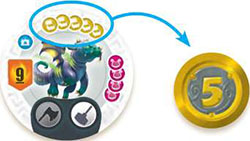
If Paul chooses to receive Gold Sovereigns as one of his two rewards for eliminating a threat, he will receive five Gold Sovereigns as shown on the Threat tile.
Place Bard Tokens 
The player takes the number of Bard tokens (of the appropriate color) shown on the Threat tile and places them in one or more Regions adjacent to their Idrakys. In the central Region, Bard tokens are always placed secretly inside the Bastion.
Bard tokens are used at the end of the game to determine each player's level of Reputation across the Kingdom.
Note: A player who has already placed all their Bard tokens may not choose this reward.

As one of his two rewards, Paul has chosen for the local lord to send out Bards to sing his praises in the neighboring Regions. He may place four tokens in Regions adjacent to his Idrakys, as shown on the Threat tile. If he decides to place any Bard tokens in the central Region, they are placed in the Bastion where they remain secret until the end of the game.
Build Sorcerers' Guild Stories 
The player takes the number of Sorcerers' Guild Stories shown on the Threat tile and places them next to the City, on the space marked with the symbol 

Note that the following restrictions apply:
- Sorcerers' Guilds cannot be more than four stories tall.
- There can be only one Sorcerers' Guild in each City.
- A player may increase the number of stories in an existing Sorcerers' Guild built by their Idrakys by eliminating another threat (subject to the height limit of four stories).
In other words, a City can never have more than one Sorcerers' Guild or have a Sorcerers' Guild with stories of different colors.
Sorcerers' Guild Stories are used at the end of the game to determine each player's level of Influence with the magical community.
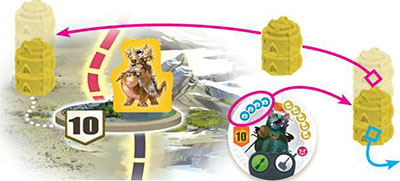
Alex has chosen to build Sorcerers' Guild Stories. The Threat tile allows him to build up to four stories of his color on the designated space next to the occupied city. As he already has a two-story tower in this City, he may add only two of his four stories, bringing his tower up to the height limit. The other two unused stories remain in his personal stockpile.
Wait
Selecting the Wait icon  instructs an Idrakys not to move or perform an action in its current location.
instructs an Idrakys not to move or perform an action in its current location.

Phase Three: City Tile Management
A. Renewing Recruitment And Threat Tiles
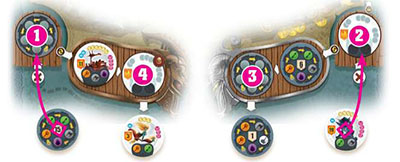
-
Remove a Recruitment or Threat tile from the Game Board:
When a player recruits the last Unit present in a City, remove the Recruitment tile from the City and place it on the Recruitment discard pile
1.When a player eliminates a threat by providing the Units required in order to defend the City, remove the Threat tile from the City and place it on the Threat discard pile
2.
-
Place A New Recruitment Or Threat Tile On The Game Board:
When a Recruitment or Threat tile is removed, you must immediately place another one on the Game Board. If a Recruitment tile has been removed, take the tile currently located on the Next Recruitment space
3and place it on the corresponding City on the Game Board. Similarly, if a Threat tile has been removed, take the tile on the Next Threat space4.When a new Recruitment tile is placed on the Game Board, if one or more requested Units are no longer available in the Barracks, leave the tile incomplete. Do not fill the empty locations with Units of a different type.
-
Replenish the Recruitment Queue and Threat Queue:
When a Recruitment tile is moved to a City, immediately take the top tile on the Recruitment pile and place it in the Next Recruitment space.
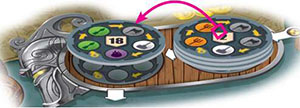
When a Threat tile is moved to a City, immediately take the top tile on the Threat pile and place it on the Next Threat space.

If the Recruitment or Threat pile is empty, it must be replenished immediately:
If the Recruitment pile is empty, collect the tiles from the Threat Discard pile and turn them over to reveal the Recruitment side. These tiles now form the new Recruitment pile.
1.If the Threat pile is empty, collect the tiles from the Recruitment Discard pile and turn them over to reveal the Threat side. These tiles now form the new Threat pile.
2.
If there are no tiles in either of the discard piles with which to form a new Recruitment or Threat pile, leave the Recruitment pile or Threat pile space empty.
If there are no more tiles in the Recruitment Queue and the Recruitment pile cannot be replenished, take the top tile from the Threat pile and place it, Recruitment side up, on the Next Recruitment space.

If there are no more tiles in the Threat Queue and it is not possible to replenish the Threat pile, perform the Awakening of the Titans and Arrival of Reinforcements events immediately. Multiple Awakening of the Titans and Arrival of Reinforcements events may occur during a game.
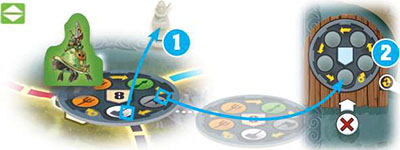
Paul has recruited the last remaining Unit on the Recruitment tile for City no. 8
1. Before resolving the next player's Order, this tile must be placed on the Recruitment Discard pile2.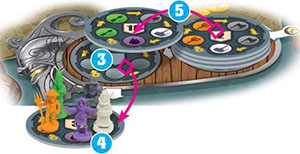
Paul then takes the Next Recruitment tile
3places it on the appropriate City and places the five specified Units on it4. Lastly, he takes the top tile from the Recruitment pile and places it on the Next Recruitment space5.
City Tiles - Forward Planning
It is possible to anticipate the appearance of a particular Recruitment or Threat tile and issue Orders for the current Game Year accordingly. Players can see which Recruitment and Threat tiles will be placed on the Game Board next by looking at the Recruitment Queue and the Threat Queue.
1Tile no. 12 is currently in the Next Threat space, and will therefore be the next Threat tile placed on the Game Board. Stephanie believes that Paul or Alex will eliminate a threat during the Game Year, as a consequence of which tile no. 12 will be placed on the Game Board.
2Planning ahead, she instructs her Idrakys to eliminate a threat in City no. 12 as her sixth Order.
3As she correctly predicted, Threat tile no. 12 is indeed placed on the Game Board. Her sixth order is therefore valid, enabling her to eliminate the threat facing City no. 12.
B. Awakening of the Titans and Arrival of Reinforcements
Titan Tiles
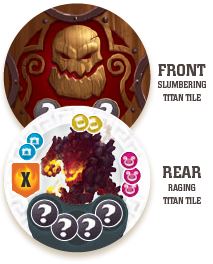
Titan tiles are double-sided:
- When the Front is visible, they are referred to as Slumbering Titan tiles. Slumbering Titan tiles have no effect on the game.
- When flipped so that the Rear is visible, they are known as Raging Titan tiles. Raging Titan tiles behave like new threats that players can eliminate.
Awakening Of The Titans
1 If there are no more tiles in the Threat Queue and it is not possible to replenish the Threat pile, perform the Awakening of the Titans event.

2 Each Slumbering Titan tile on the top of each Titan pile is then flipped to reveal its Raging Titan side.
- If there are still one or more Raging Titan tiles on top of one or more piles, leave them as they are. Only flip Slumbering Titan tiles on the top of piles.
1 - If there are no more Titan tiles in one or more of the piles in the Titans' Lair, no additional Slumbering Titans are awakened in that pile.
2

Note: The Arrival of Reinforcements event is also systematically triggered, regardless of the state of the Titan piles.
Arrival Of Reinforcements
Whenever the Awakening of the Titans event occurs, Reinforcements arrive as follows:
-
Collect all tiles in the Threat Discard pile and flip them over.
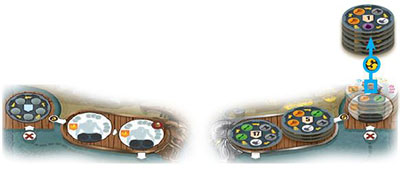
-
Place the remaining tiles from the Recruitment pile on top of these tiles.
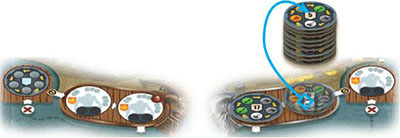
-
Take the first two tiles from this new pile to form a new Recruitment pile. Place this pile on the Recruitment pile space.
-
Shuffle the remaining tiles and flip them over to form the new Threat pile. Place this pile on the Threat pile space.
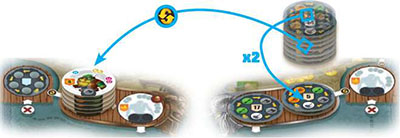
-
Take the top tile from the Threat pile and place it on the Next Threat space.

Eliminating A Raging Titan Tile
A Raging Titan tile behaves as a new threat. Players may eliminate it in the same way as a Threat tile. However, the following exceptions apply:
Raging Titan tiles are not associated with a particular City. They may therefore be eliminated from any City that does not already contain a Threat or Recruitment tile.
When eliminating a Raging Titan tile, the type of Units required is not specified. For each icon ? shown on the tile, the player takes one unit of their choice from behind their Screen and returns it to the Barracks.
It is not possible to eliminate a Threat tile and a Titan tile or eliminate multiple Titan tiles in the same City during the same Game Year.
When a Raging Titan tile is eliminated, it is removed from play and placed in the game box.
If there is no longer a Threat or Recruitment tile on a City when a player performs an action but a Raging Titan tile is still available, the player is not obliged to eliminate the Titan.
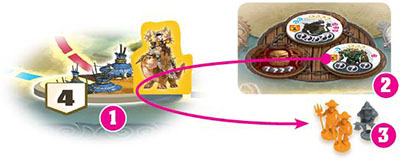
Alex is in City no. 4, which does not contain a City tile O He has not yet performed an action in that City this turn. The Order issued to his Idrakys is to perform an action There are two Raging Titan tiles in the Titans' Lair. Alex decides to eliminate the Titan that requires only three Units £2 . He takes three Units of his choice from behind his Screen and returns them to the Barracks G The eliminated Titan tile is removed from play and placed in the game box.
Phase Four: Military Census
A Military Census is performed at the end of Game Years 4, 8 and 12. The players with the most of each type of Unit receive a reward from the Kingdom's noble houses.
Each of the five types of Unit (Peasant Militia / Archers / Infantry / Clerics / Battle Mages) is subject to the census. Each player secretly places the number of Units of the first type (Peasant Militia) that they wish to reveal to all players in one hand. Players are under no obligation to reveal all their Units.
All players open their hand simultaneously to reveal their Units. The player who reveals the most Units of the specified type receives a reward.
The same procedure is then repeated for the other four types of Unit.
Note: After each Military Census, revealed Units are put back behind the players' Screens.
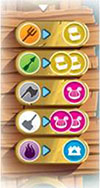
- The player with the most Peasant Militia Units receives 1 Gold Sovereign token of value 1.
- The player with the most Archers receives 2 Gold Sovereign tokens of value 1.
- The player with the most Infantry may place 1 Bard token in a Region adjacent to their Idrakys.
- The player with the most Clerics may place 2 Bard tokens in either one or two Regions adjacent to their Idrakys.
- The player with the most Battle Mages may add one story to an existing Sorcerers' Guild, subject to the normal height limit.
Note: If a player who has not yet built a Sorcerers' Guild wins the Battle Mage reward, this bonus story should be placed behind their Screen. As soon the player is able to add this story to other stories in a Sorcerers' Guild built by their Idrakys, they must place it on the Game Board.
If two or more players tie for the majority during one of the censuses, they each collect 1 Gold Sovereign token or place 1 Bard token or 1 Sorcerers' Guild story, depending on the type of reward granted by the noble houses.
Note: Tied players entitled to place Bard tokens must place them in the order of play (the player nearest the First Player token is the first to place their Bard token).

Steve, Paul, Stephanie and Alex are conducting a census of their Clerics. Steve and Paul each show one Cleric, Alex does not show any and Stephanie shows two. Stephanie has a majority and is therefore entitled to place a total of two Bard tokens in one or two Regions adjacent to her Idrakys.
End Of The Game Year
When all players have carried out all their Orders for the current Game Year, and following the Military Census in years 4 and 8, move the Year marker forward one space. The first player passes the First Player token to the player to their left. Phase One of the next Game Year may then begin.
End of the Game
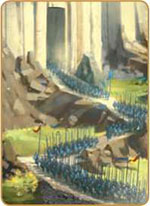
This is phase 6. The game ends after the final Military Census at the end of the 12th Game Year.
At the end of the game, three consecutive assessments are performed. Each assessment ranks the players based on either their Wealth, their level of Influence with the magical community or their Reputation across the Kingdom.
During the first assessment, one player (or two players in a five-player game) is eliminated. During the second assessment, another of the remaining players is eliminated. Last but not least, the third assessment eliminates one of the two surviving players.
The only player still in contention is declared the winner.

The Three Assessment Tiles
The Hall of Fame is divided into three columns, each with a corresponding Assessment tile 1.
There are three Assessment tiles:
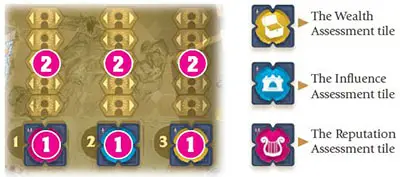
Five boxes are shown above each of these tiles 2. Their purpose is to rank the players during each of the three assessments.
Note: The order in which these Assessments are performed is determined randomly at the start of each game.
First Assessment
Identify the first Assessment tile and carry out the first assessment.
-
If This Is The Wealth Assessment Tile:

A player's Wealth is considered to be the combined value of all the Gold Sovereign tokens accumulated during the game.
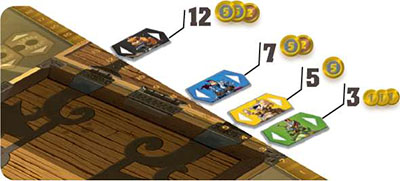
Each player uses one of their three Active Player Score tokens to show their level of Wealth on the Score Track.
-
For The Influence Assessment Tile:

A player's level of Influence with the magical community is determined by the number of Sorcerers' Guild Stories of their color placed on the Game Board.
Note: Any Sorcerers' Guild Stories that a player may have behind their Screen but was unable to place on the Game Board during the game (because all their Sorcerers' Guilds already had the maximum four stories) are ignored during the Influence assessment.

Each player uses one of their three Active Player Score tokens to indicate their level of Influence with the magical community on the Score Track.
-
For The Reputation Assessment Tile:

Each player's Reputation across the Kingdom is evaluated after examining all the Regions on the Game Board in which Bard tokens have been placed. The contents of the Bastion are then revealed.
For each Region, the player with the most Bard tokens scores reputation points equal to the greater of the two numbers shown in the Region's scoring symbol. The player with the second-highest number of Bard scores reputation points equal to the smaller of the two numbers shown in the Region's scoring symbol.
If two or more players tie for first place, each player scores reputation points equal to the greater of the two numbers in the Region's scoring symbol. If there is a tie for first place, no points are awarded for second place.
If two or more players tie for second place, each player scores reputation points equal to the smaller of the two numbers in the Region's scoring symbol.
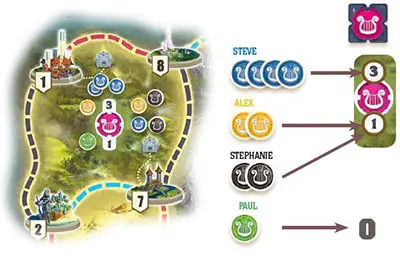
A player's level of Reputation across the Kingdom is the combined value of the reputation points acquired in the various Regions. Each player uses one of their three Active Player Score tokens to show their level of Reputation on the Score Track.
Ranking players during the first Assessment
The player whose Active Player Score token is highest on the Score Track moves their Score token to the top box in the Hall of Fame's first column.
The player whose Active Player Score token is second-highest on the Score Track moves their Score token to the next box in the same column in the Hall of Fame. Repeat the procedure for the remaining players to obtain a final ranking.
If two or more players tie, they should stack their Active Player Score tokens in the same box in the Hall of Fame.
Resolving Ties
If two or more players are tied in the Hall of Fame, the tie is broken by comparing the total number of Units behind the Screens of the players concerned. The player with the most units wins the tie.
The stacked Score tokens can then be separated. If players are still tied, the player furthest from the First Player token (in the direction of play) wins the tie.
Eliminating A Player
When the players have been ranked, the lowest-ranked player is eliminated. Show this by flipping the eliminated player's Active Player Score token to show its Eliminated side in the Hall of Fame.
Important: In a five-player game, TWO players are eliminated during the first assessment.
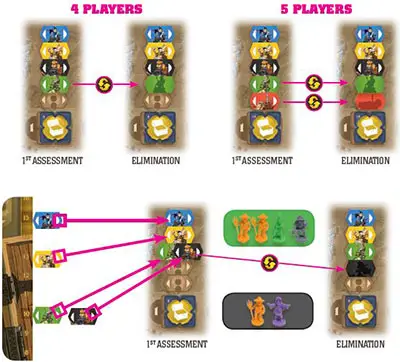
During the Wealth assessment, Stephanie and Paul are tied in last place and each has 18 Gold Sovereigns. To break the tie, they compare the number of Units behind their respective Screens. Stephanie has a total of 2 Units and Paul has 4. Stephanie is therefore eliminated and her Active Player Score token is flipped onto its Eliminated side.
Second And Third Assessments
The procedure for the second and third assessments is the same as for the first assessment, except that the Score tokens of any players eliminated in a previous assessment are placed on their Eliminated side. Ignore these Score tokens when determining the lowest-ranked player in the current assessment.
After the third assessment, the one remaining player whose Score token is still placed Active side up wins the game and is declared "Savior of the Kingdom".
Continue Reading
